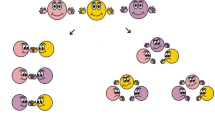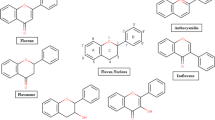Abstract
The antioxidant activity of equimolar binary combinations of ten natural phenolic compounds (vanillic acid, vanillin, hydroquinone, caffeic acid, ellagic acid, resveratrol, genistein, kaempferol, quercetin and catechin) with gallic acid or its alkyl esters (propyl-, octyl- and dodecyl gallates) was determined measuring the scavenging 2,2′-azino-bis(3-ethylbenzothiazoline-6-sulphonic acid) radical cation activity. Statistical significant antagonism was found for all combinations with gallic acid and for most combinations with alkyl esters. Statistical significant synergism was observed only for three combinations of dodecyl gallate with resveratrol, genistein or catechin. The antagonistic and synergistic effects were analysed from regeneration mechanisms, and most of them can be explained according to the one-electron reduction potentials of the phenolics selected. These results may facilitate the use of combinations of antioxidants, as part of the hurdle technology, which can be applied to different aspects of food preservation, in order to increase shelf life and retain nutritional quality.
Similar content being viewed by others
References
Valko M, Leibfritz D, Moncola J, Cronin MTD, Mazura M, Telser J (2007) Free radicals and antioxidants in normal physiological functions and human disease. Int J Biochem Cell B 39:44–84
Pokorný J (2007) Are natural antioxidants better –and safer-than synthetic antioxidants? Eur J Lipid Sci Technol 109:629–642
Martínez ML, Penci MC, Ixtaina V, Ribotta PD, Maestri D (2013) Effect of natural and synthetic antioxidants on the oxidative stability of walnut oil under different storage conditions. LWT Food Sci Technol 51:44–50
Hwang K-E, Kim H-W, Song D-H, Kim Y-J, Ham Y-K, Lee J-W, Choi Y-S, Kim Ch-J (2015) Effects of antioxidant combinations on shelf stability of irradiated chicken sausage during storage. Radiat Phys Chem 106:315–319
Abarikwu SO, Akiri OF, Durojaiye MA, Alabi AF (2014) Combined administration of curcumin and gallic acid inhibits gallic acid-induced suppression of steroidogenesis, sperm output, antioxidant defenses and inflammatory responsive genes. J Steroid Biochem Mol Biol 143:49–60
Fernández-Álvarez L, del Valle P, de Arriaga D, García-Armesto MR, Rúa J (2014) Binary combinations of BHA and other natural and synthetic phenolics: antimicrobial activity against Staphylococcus aureus and antioxidant capacity. Food Control 42:303–309
Choe E, Min DB (2009) Mechanisms of antioxidants in the oxidation of foods. Compr Rev Food Sci Food Saf 8:345–358
Floegel A, Kim D-O, Chung S-J, Koo SI, Chun OK (2011) Comparison of ABTS/DPPH assays to measure antioxidant capacity in popular antioxidant-rich US foods. J Food Compost Anal 24:1043–1048
EFSA (European Food Safety Authority) (2010) Scientific opinion on flavouring group evaluation 20, revision 2 (FGE.20Rev2): benzyl alcohols, benzaldehydes, a related acetal, benzoic acids, and related esters from chemical groups 23 and 30. EFSA panel on food contact materials, enzymes, flavourings and processing aids. EFSA J 8:1405
Commission Regulation (EU) No 1129/2011 of 11 November 2011 amending Annex II to Regulation (EC) No. 1333/2008 of the European Parliament and of the Council by establishing a Union list of food additives. OJ L 295 54:1–177
Kubo I, Masuoka N, Ha TJ, Shimizu K, Nihei K (2010) Multifunctional antioxidant activities of alkyl gallates. TOBCJ 3:1–11
Gutiérrez-Larraínzar M, Rúa J, Caro I, de Castro C, de Arriaga D, García-Armesto MR, del Valle P (2012) Evaluation of antimicrobial and antioxidant activities of natural phenolic compounds against foodborne pathogens and spoilage bacteria. Food Control 26:555–563
Gutiérrez-Fernández J, García-Armesto MR, Álvarez-Alonso R, del Valle P, de Arriaga D, Rúa J (2013) Antimicrobial activity of binary combinations of natural and synthetic phenolic antioxidants against Enterococcus faecalis. J Dairy Sci 96:4912–4920
Gutiérrez-Larraínzar M, Rúa J, de Arriaga D, del Valle P, García-Armesto MR (2013) In vitro assessment of synthetic phenolic antioxidants for inhibition of foodborne Staphylococcus aureus, Bacillus cereus and Pseudomonas fluorescens. Food Control 30:393–399
Ozgen M, Reese N, Jr Tulio AZ, Scheerens JC, Miller AR (2006) Modified 2,2-azino-bis-3-ethylbenzothiazoline-6-sulfonic acid (ABTS) method to measure antioxidant capacity of selected small fruits and comparison to ferric reducing antioxidant power (FRAP) and 2,2´-diphenyl-1-picrylhydrazyl (DPPH) Methods. J Agric Food Chem 54:1151–1157
Zyzelewicz D, Zaklos-Szyda M, Juskiewicz J, Bojczuk M, Oracz J, Budryn G, Miskiewicz K, Krysiak W, Zdunczyk Z, Jurgonski A (2016) Cocoa bean (Theobroma cacao L.) phenolic extracts as PTP1B inhibitors, hepatic HepG2 and pancreatic β-TC3 cell cytoprotective agents and their influence on oxidative stress in rats. Food Res Int 89:946–957
Peyrat-Maillard MN, Cuvelier ME, Berset C (2003) Antioxidant activity of phenolic compounds in 2,2´-azobis(2-amidinopropane) dihydrochloride (AAPH)-induced oxidation: synergistic and antagonistic effects. J Am Oil Chem Soc 80:1007–1012
Lu Z, Nie G, Belton PS, Tang H, Zhao B (2006) Structure-activity relationship analysis of antioxidant ability and neuroprotective effect of gallic acid derivatives. Neurochem Int 48:262–274
Losada-Barreiro S, Bravo-Díaz C, Paiva-Martins F, Romsted LS (2013) Maxima in antioxidant distributions and efficiencies with increasing hydrophobicity of gallic acid and its alkyl esters. The pseudophase model interpretation of the “cutoff effect”. J Agric Food Chem 61:6533–6543
Ji H-F, Zhang H-Y, Shen L (2006) Proton dissociation is important to understanding structure-activity relationships of gallic acid antioxidants. Bioorg Med Chem Lett 16:4095–4098
Frankel EN, Huang SW, Kanner J, German JB (1994) Interfacial phenomena in the evaluation of antioxidants: bulk oil vs emulsions. J Agric Food Chem 42:1054–1059
Koga T, Terao J (1995) Phospholipids increase radical-scavenging activity of vitamin E in a bulk oil model system. J Agric Food Chem 43:1450–1454
Cuvelier C, Bondet V, Berset C (2000) Behaviour of phenolic antioxidants in a partitioned medium: structure-activity relationship. J Am Oil Chem Soc 77:819–823
He S, Yan X (2013) From resveratrol to its derivatives: new sources of natural antioxidant. Curr Med Chem 20:1005–1017
Gunckel S, Santander P, Cordano G, Ferreira J, Muñoz S, Nunez-Vergara LJ, Squella JA (1998) Antioxidant activity of gallates: an electrochemical study in aqueous media. Chem Biol Interact 114:45–59
Zhang D, Chu L, Liu Y, Wang A, Ji B, Wu W, Zhou F, Wei Y, Cheng Q, Cai S, Xie L, Jia G (2011) Analysis of the antioxidant capacities of flavonoids under different spectrophotometric assays using cyclic voltammetry and density functional theory. J Agric Food Chem 59:10277–10285
Leopoldini M, Marino T, Russo N, Toscano M (2004) Antioxidant properties of phenolic compounds: H-atom versus electron transfer mechanism. J Phys Chem A 108:4916–4922
Zhang J, Du F, Peng B, Lu R, Gao H, Zhou Z (2010) Structure, electronic properties, and radical scavenging mechanisms of daidzein, genistein, formononetin, and biochanin A: a density functional study. J Mol Struct THEOCHEM 955:1–6
Senthil Kumar K, Kumaresan R (2012) A DFT study on the structural, electronic properties and radical scavenging mechanisms of calycosin, glycitein, pratensein and prunetin. Comput Theor Chem 985:14–22
Lengyel J, Rimarčik J, Vagánek A, Klein E (2013) On the radical scavenging activity of isoflavones: thermodynamics of O–H bond cleavage. Phys Chem Chem Phys 15:10895–10903
Komorsky-Lovrić Ŝ, Novak I (2011) Determination of ellagic acid in strawberries, raspberries and blackberries by square-wave voltammetry. Int J Electrochem Sci 6:4638–4647
Jovanovic SV, Steenken S, Hara Y, Simic MG (1996) Reduction potentials of flavonoid and model phenoxyl radicals. Which ring in flavonoids is responsible for antioxidant activity? J Chem Soc Perkin Trans 2:2497–2504
Foley S, Navaratnam S, McGarvey DJ, Land EJ, Truscott TG, Rice-Evans CA (1999) Singlet oxygen quenching and the redox properties of hydroxycinnamic acids. Free Radic Biol Med 26:1202–1208
Jovanovic SV, Hara Y, Steenken S, Simic MG (1995) Antioxidant potential of gallocatechins—a pulse-radiolysis and laser photolysis study. J Am Chem Soc 117:9881–9888
Jovanovic SV, Steenken S, Tosic M, Marjanovic B, Simic MG (1994) Flavonoids as antioxidants. J Am Chem Soc 116:4846–4851
Fang J-G, Zhou B (2008) Structure-activity relationship and mechanism of the tocopherol-regenerating activity of resveratrol and its analogues. J Agric Food Chem 56:11458–11463
Kung KH, McBride MB (1988) Electron transfer processes between hydroquinone and iron oxides. Clay Clay Miner 36:303–309
Han R-M, Tian Y-X, Liu Y, Chen Ch-H, Ai X-Ch, Zhang J-P, Skibsted LH (2009) Comparison of flavonoids and isoflavonoids as antioxidants. J Agric Food Chem 57:3780–3785
Jovanovic SV, Simic MG (2000) Antioxidants in nutrition. Ann N Y Acad Sci 899:326–334
Khopde SM, Priyadarsini I (2000) Application of Marcus theory of electron transfer for the reactions between HRP compound I and II and 2,4-disubstituted phenols. Biophys Chem 88:103–109
Author information
Authors and Affiliations
Corresponding author
Ethics declarations
Conflict of interest
None.
Compliance with ethical requirements
This article does not contain any studies with human or animal subjects.
Additional information
Javier Rúa and Pilar del Valle have contributed equally to this work.
Rights and permissions
About this article
Cite this article
Rúa, J., de Arriaga, D., García-Armesto, M.R. et al. Binary combinations of natural phenolic compounds with gallic acid or with its alkyl esters: an approach to understand the antioxidant interactions. Eur Food Res Technol 243, 1211–1217 (2017). https://doi.org/10.1007/s00217-016-2838-2
Received:
Revised:
Accepted:
Published:
Issue Date:
DOI: https://doi.org/10.1007/s00217-016-2838-2




